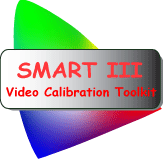SMART III - Video Calibration Toolkit
Steve Smallcombe's SMARTAVTWEAKS site

The idea of the CC filter is that with many fixed panel projectors, and certainly the SONYs with which I am the most familiar, have lack of color balance in their light source. Typically red is in short supply. So in order to achieve the maximum contrast ratio while maintaining proper color balance the red panel is driven to near max, and the green a blue panels are not.
Furthermore, the light at the lowest IRE levels is typically dominated
by leakage and thus does not respond to controls. CC filters can also
be very useful in correcting the color balance of the light at these very
low light levels.
Since the contrast ratio for the projector is determined by ratio of the
light transmitted to the light leakage at IRE 0, driving the blue and
green panels at less than full light output limits brightness and contrast
ratio. Of course you could simply drive the green and blue panels at their
max as well, and you would an increased contrast ratio, but color balance
would obviously suffer as red can't be increased proportionally.
The tough part of increasing the contrast ratio of these projectors is
to do so while maintaining color balance and grayscale tracking. One way
of doing this would be to use a balanced color source within the projector,
as then all three panels could be driven for maximum contrast ratio. If
this is not done by the manufacturer, then a practical way to achieve
the same benefits is to add an external Color Correcting filter in front
of the lens. Fortunately such CC filter are widely available for photographic
use and those designed to pass red and absorb green and blue equally are
called CC xxR filters where the xx are numbers that indicate the extent
of the blue/green filtering.
For the SONY 10HT and 11HT, the most commonly used filters are the CC30R
and CC40R. filters that preferentially absorb green and blue and pass
most all the red. Use of a CCxxR filter by itself obviously messes up
the color balance, but when used with a corresponding increase in the
drive levels of the green and blue panels, one can achieve the better
contrast ratio AND the proper color balance. Once all three panels are
driven to near their max, that is probably the best contrast ratio you
can possibly get from that projector. And since all three panels are driven
more or less equally, grayscale or gamma tracking are typically also improved.
In practice since the increased drive levels compensate for the loss of
green and blue light at the higher IRE levels, one doesn't lose too much
brighness or Lumens in the process, only about 10%. But since the CC filters
absorb 50 percent or so of the green and blue light, the leakage levels
through the panels at IRE 0 are significantly attenuated thus giving a
much better black level as well.
In the ideal world, the leakage light at IRE 0 will resemble the bulb light and the same CC filter that optimizes the contrast ratio and balances the performance of the panels at the high IRE levels will also correct the color balance of the leakage light at IRE 0. This is often the case, but in other cases it may be necessary to choose a filter to optimize one aspect of the projectors performance, e.g. contrast ratio, and let the lower IRE levels be slightly out of balance.
The use of CC filters is certainly the cheapest $30 to $100, and probably
the most effective way of increasing contrast ratios and black levels
for many fixed panel projectors, the performance of which is often limited
by an unbalanced light source.
In the process of setting up with CC filters it is certainly desirable
to have some way of measuring and reproducing color ratios. This can of
course be done using a professional color analyzers, if available, but
many have found the SMART measurement process an effective low cost alternative.
The rest of this web-site describes in detail how to use SMART and CC filters.
Introduction to how SMART works
Frequently Asked Questions about SMART
Here is what's new is SMART III version 1.2
The Dummies Guide explains the SMART process in a non-technical way
Buy SMART III at EnhancedHT - your exclusive source for all SMART products
Having trouble? Learn the most common mistakes people make using SMART
Read about using bias lights to improve perceived black levels.
Here are some additional tips for the SONY projectors and solution to common problems.